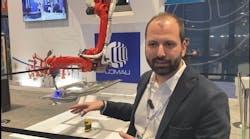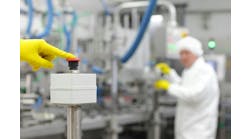Mike Bacidore is the editor in chief for Control Design magazine. He is an award-winning columnist, earning a Gold Regional Award and a Silver National Award from the American Society of Business Publication Editors. Email him at [email protected].
Everyone wants to have a finger on the pulse of manufacturing, said Raj Batra, president, Digital Factory, Siemens. “We’re living in this age of transformative technologies,” he said to open Siemens’ Manufacturing in America Symposium in Detroit. “Industrial companies large and small have the opportunity to reinvent themselves. “By 2020 it’s estimated that more than 80% of manufacturers will embrace the Internet of Things, which will become a $7.1 trillion market.”
The consumer world has yielded numerous success stories in the world of digital data. “In industry, data has more value,” explained Batra. “It will give our customers the opportunity to know their assets and keep them running. Modernization is overdue. You hear a lot about aging assets. According to ARC Advisory Group, there are $65 billion of assets looking at the end of their useful lives. And Morgan Stanley says the average age of equipment in the United States industrial space is the highest it’s been since 1938.”
In this sea of aging assets, Batra sees a clear path to modernization.
“Industry is able to achieve more speed, agility and efficiency than ever before,” he said. It’s taking processes that were serial and making them into parallel processes through seamless integration of product and production. Siemens has made $4 billion in acquisitions since 2007 to create a comprehensive portfolio of hardware and software. By converging product and production, we can achieve seamless integration. Achieving a better understanding of the changes is the task that lies ahead for all of us.”
What lies ahead
Do we have the right environment to prosper here in North America? “There’s a lot of prosperity to be had here, going forward,” explained Brian Beaulieu, author of “Prosperity in the Age of Decline” and CEO, ITR Economics. “We are moving into an environment where it is economically logical to take some risks. This is a great time to make a move.”
Beaulieu predicted that U.S. real GDP will continue to rise into 2018. “We are the world’s largest economy. The United States is 22.7% of global GDP. We’re going to remain the world’s largest economy for the next 50 years,” said Beaulieu, who explained that China is second with 12.4% of global GDP, Japan is third at 6.6%, Germany has 4.9% and France has 3.7%.
Also Read: Siemens' Raj Batra Joins NEMA Board of Governors
“We’re No. 1, and we’re going to be staying that way for a very long time,” said Beaulieu of the U.S. prosperity. “We are the leading economic indicator in the world. But we have an amazing number of people who are structurally unemployed. They don’t have the skill sets. We haven’t been training people in manufacturing. We have 2.4% private sector employment growth, but we have 16.1% job openings.” He cited a a 10.7% year-over-year increase in job openings in manufacturing.
Beaulieu explained that millennials bring a new workforce paradigm. “You’re lucky if they’ll work for you for three years before they quit,” he said. “They’re different. To be digitized is one thing, but to have a digital factory, you also have to be able to retain the people who are working for you. Labor price inflation is just starting here in the United States.”
As interest rates continue to decline, he suggested that now is the time to invest in the future. “We need to invest in ourselves in America at these very low interest rates,” he explained. “How much? If you’re sleeping through the night, you have not borrowed enough money. Now is the time to make that move.”
Beaulieu mentioned near-sourcing or insourcing trends, as well. “Labor is getting more expensive on the planet,” he said. “In the United States, we’re exceedingly good at harvesting capital and employing it to solve problems, but we’re not known for cheap labor. Manufacturing also requires cheap reliable energy, and the last six months have shown us we can have that in America. We own our energy future now, going forward. In 2005, we had 60% dependence on foreign oil. In 2013, it was 32%. That makes us an extremely attractive platform.”
Finally, Beaulieu advised us to ensure that our children learn three languages. “First, make sure they learn to speak proper English,” he suggested. “Second, they should learn French because it is the language of Africa, a rising continent. And the third language is math.”
Digital manufacturing
George Barnych, director of R&D programs, Digital Manufacturing and Design Innovation Institute (DMDII), spoke about the bleak picture of the trade balance and the role that advanced technology products play in his organization and in the United States.
The DMDII is a hub designed to advance digital manufacturing in the United States. “It’s designed to fill a gap,” said Barnych. “We know industry puts a lot of money into manufacturing and R&D.”
He noted past trends to send manufacturing elsewhere for cheaper costs, but there are definite disadvantages. “Outsourcing separates the designers from the makers, and that slows innovation,” said Barnych. “There’s opportunity is to create a digital link between the two. Another barrier is sharing data and information, but connectivity helps with that.”
The amount of data generated by manufacturing is 1,812 petabytes, according to research from McKinsey, he said. Government is second at 911 petabytes. “In 2011, President Obama put together a team of people, mostly CEOs, to determine how the United States could regain the lead in digital manufacturing. And the Revitalize American Manufacturing Act became law in December 2014. The National Network for Manufacturing Innovation was designed to create a series of institutes, of which DMDII is one.”
Digital manufacturing is an integrated suite of tools that work with product definition data to support tool design, manufacturing process design, visualization, modeling and simulation, data analytics and other analyses necessary to optimize the manufacturing process, according to product-lifecycle-management (PLM) consultancy, CIMData. “Our goal is to help to increase the competitiveness in American manufacturing through an integration of a suite of tools,” said Barnych.
The DMDII on GooseIsland near Chicago has seven discrete cells for different applications such as multi-axis high-end machining, traditional/legacy standard machining and additive manufacturing. “We manage $70 million in federal funding,” said Barnych. “Technology focus areas include advanced manufacturing enterprise (AME), intelligent machining (IM) and advanced analysis (AA). AME is the digital thread. So far, we’ve had three project calls released. We’re looking at 20-25 projects anticipated from the 12 project subject areas that have been addressed. Our project call defines a gap or defines a problem. You don’t need to be a member to put a proposal together. The next proposals or white papers are due April 1. It would not be unusual for us to create two contracts for two separate solutions.”




